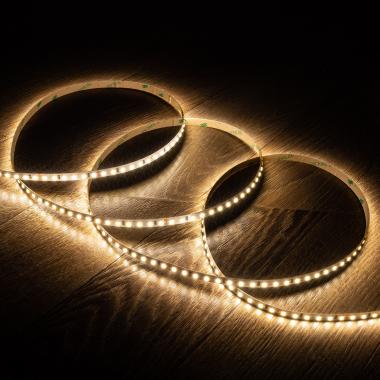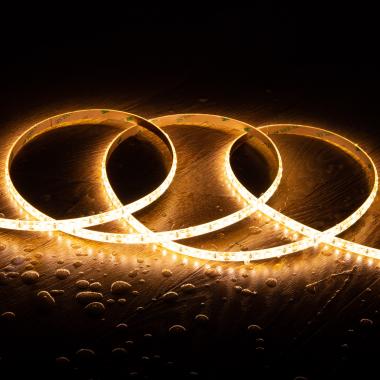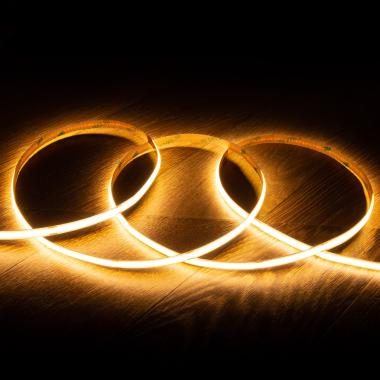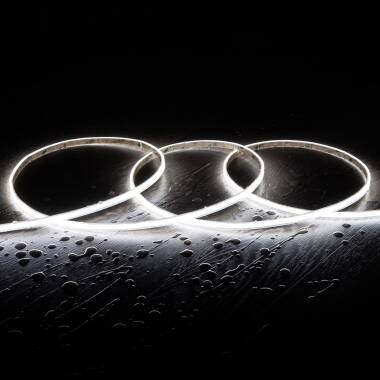LED strip lights
Thanks to their versatility and ease of installation, LED strips allow a wide range of uses ranging from decoration to other professional uses.

Our featured products from LED strip lights

Range Essential
13,61 €
Ref 108138
5m 24V DC LED Strip SMD2835 120LED/m 8mm Wide Cut at Every 5cm IP20
In Stock, delivery in 15-20 days
- Voltage Range 24V DC
- Cut Points 5 cm
- IP Rating IP20
4 options
Range Essential
15,95 €
Ref 108150
5m 24V DC LED Strip SMD2835 120LED/m 8mm Wide Cut at Every 5cm IP65
In Stock, delivery in 15-20 days
- Voltage Range 24V DC
- Cut Points 5 cm
- IP Rating IP65
4 options
Range Advanced
18,19 €
Ref 108187
5m 24V DC LED Strip COB 320LED/m CRI90 8mm Wide Cut at Every 5cm IP20
In Stock, delivery in 15-20 days
- Voltage Range 24V DC
- Cut Points 5 cm
- IP Rating IP20
4 options- -20%

Range Advanced
Before 28,49 €
22,79 €
Ref 126411
5m 24V DC LED Strip COB 320LED/m CRI90 10mm Wide Cut at Every 5cm IP65
In Stock, delivery in 15-20 days
- Voltage Range 24V DC
- Cut Points 5 cm
- IP Rating IP65
4 options
Brands related to this category
About LED strip lights
In addition, as they can be cut and spliced, LED strip lights give you total freedom to choose the distance to be covered. The only thing you have to do is to pre-calculate the power required for the surface to cover to ensure proper operation.
What types of LED strips are there?
Our online store has different types of LED strips so you can choose according to different criteria such as power supply, the number of LEDs per meter, the color of the light or weather resistance.
Depending on the power supply, we have:
- LED strips 220V AC (alternating): They are connected directly to the mains.
- LED strips 12V and 24V DC (continuous): They are connected to a power supply.
As for the number of LEDs per meter of the strip, the most common values are: 30 LED/m, 60 LED/m, 120 LED/m. Of course, if we compare strips with the same type of LED, the strips that have a higher number of LEDs per meter will emit more light.
Regarding the color of light we can differentiate:
- Single-color strips, which emit only one color of light, either white (warm, cold, neutral), blue, green, etc.
- RGB or multicolor strips, with variants such as RGBW, which can change the color of the light. The latter are usually controlled by a remote control that allows you to choose the color and intensity of the light and even create lighting effects.
Finally, we must differentiate between LED strips that can only be used indoors and those that can be used outdoors. The outdoor LED strips usually have an IP protection factor of 65 or higher.
How to install LED strips?
Depending on the type of strip or where the installation takes place, the process may vary slightly, although in general it is very simple and does not require any training.
The 220V AC strips are very easy to install as they do not require a power supply:
- Check that the rectifier used to connect the strip to the mains is capable of supporting the length of strip required for the installation.
- Choose the type of rectifier/controller suitable for the type of strip (single color/RGB).
- Use a suitable fixing method (double-sided tape, staples, etc.).
For 12/24V DC strips the process is similar, but with some extra steps:
- Choose the type of strip to be installed (single color or RGB).
- Measure the space where the strip is to be placed and cut the necessary length.
- Clean the surface where the strip will be installed to ensure lasting adhesion.
- Connect the strips to a dimmer (Optional). This step is only necessary when installing RGB/RGBW LED strips or dimmable single color strips.
- Connect the power supply to the mains and to the strip.
How much light does an LED strip emit?
Depending on the type of LED and the number of LEDs per meter, each LED strip will emit a certain number of lumens per meter (lm/m). Remember that the lumen (lm) is the unit that measures the amount of light, not the watt (W). Here are some examples based on two different LED models:
- SMD 3528: 3.5 mm x 2.8 mm strips, each LED emits between 3 and 5 lumens.
- SMD 5050: 5.0 mm x 5.0 mm strips, each LED emits between 10 and 15 lumens.
Depending on the luminosity of each LED and the number of LEDs per meter, we have:
- 60 SMD 3528 SMD LEDs per meter: emit between 180 and 300 lumens per meter.
- 120 SMD 3528 SMD LEDs per meter: between 360 and 600 lm/m.
- 60 SMD 5050 LEDs per meter: between 600 and 900 lm/m.
- 72 SMD 5050 LEDs per meter: between 720 and 1,080 lm/m.
- 120 SMD 5050 LEDs per meter: between 1,200 and 1,800 lm/m.
How much power do LED strips consume?
Consumption depends on the type and number of LEDs used:
- 60 SMD 3528 LEDs per meter consume 5 W per meter strip.
- 120 SMD 3528 LEDs per meter consume 9 W per m/strip.
- 60 SMD 5050 LEDs per meter consumes 14.4 W per m/strip.
- 72 SMD 5050 SMD LEDs per meter consume 17.3 W per m/strip.
- 120 SMD 5050 LEDs per meter consume 28.8 W per m/strip.
Can LED strips be cut?
Yes, as mentioned before, the strips can be cut. Depending on the type of strip the cutting distance will be different. For example, you have strips that can be cut every 10 cm, while others can only be cut every meter. In general, when you need to cut a LED strip, you have to make sure that you do it in the places marked for it according to the model.
Where can we use LED strips?
The LED strips can be used in all kinds of spaces both indoors and outdoors. Here are some ideas that can serve as inspiration to choreograph and illuminate:
In interior spaces we can use LED strip lights to highlight architectural elements, illuminate under furniture or shelves in kitchens, bedrooms or living rooms, decorate with indirect light using ceiling moldings and much more.
In balconies, gardens and other outdoor spaces we can also surround the contour of the pool, installed in a pergola, on paths and steps or simply to delimit different spaces among others.
In commercial premises or bars and restaurants can be used to decorate and illuminate shop windows, the bar area, furniture, highlight elements of the decor, create an ambient light, the possibilities in these spaces are endless. You just have to let your imagination fly.







